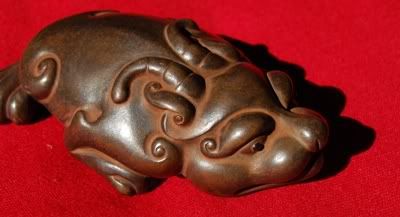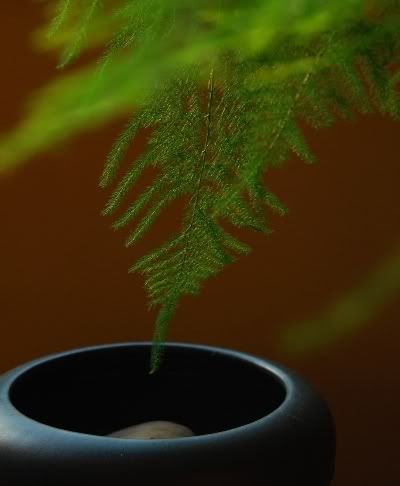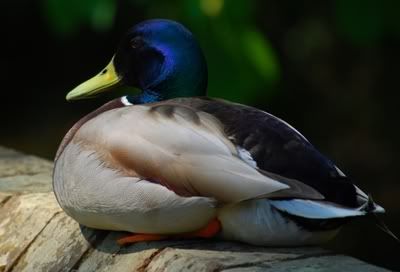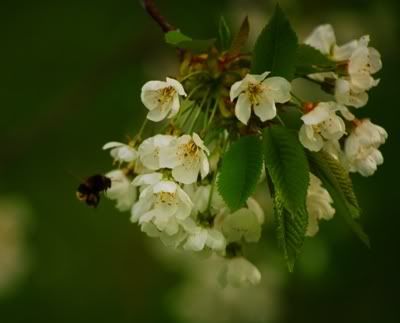Chachong is a tricky term, which is sometimes translated "tea insects". Chinese being the (poetic / frustrating) language it is, "chong" refers to "little lifeforms". Chachong are the little lifeforms that squat on our tea-trays. Having received a few messages on the subject, I thought maybe an open response is in order.
Above is Qingchan, my constant tea companion. When I'm lucky, my dear wife joins me at the tea-table, but our work hours sometimes make this impossible - those times, it's just Qingchan and me, man versus mythical frog creature.
We try to be quite "wabi sabi" in our tea sessions (and in our life generally), which means no extraneous clutter, no junk, nothing that isn't serving a well-worn, well-defined purpose. As a general principle, it means "travelling light", but if you saw our tea-table, you might not think it too light, with its flowers, chaxi [water bowl for storing cups], chadao, chahe ["tea lotus" for holding leaves], waste bowl, and a bowl of water with a rock in it.
This is the greater sense of "travelling light" - the things we have are loved, used, and moved around, and fulfil some sort of function, even if we are not sure what that function might be. Whatever actual function a bowl of water with a rock in it fulfils, it has some sort of consequence on the atmosphere, and feels "right". That's the crux of it. If it's gathering dust, get rid of it. Old and stagnant items are "stale qi", in Chinese terms.
Qingchan is made of yixing(-esque?) clay, and has accumulated a fine patina, receiving a cup from every gongdaobei of tea that I brew, and a thorough rubbing down with a cloth after the session. Like the bowl of water with the rock in it, Qingchan is beyond function - he gathers no dust, keeps me company when I am otherwise drinking alone, and that's enough for me.
Be careful when selecting chachong - it's like picking a puppy. You will have to stare at it many hours, so do not take the purchase lightly. Also, they are needy, like pets: to buy a chachong is to commit to feeding and polishing it.
I refuse to buy any more chachong (to do so would be an insult to Qingchan), but I would exhibit extreme caution were I to think about doing so.
We try to be quite "wabi sabi" in our tea sessions (and in our life generally), which means no extraneous clutter, no junk, nothing that isn't serving a well-worn, well-defined purpose. As a general principle, it means "travelling light", but if you saw our tea-table, you might not think it too light, with its flowers, chaxi [water bowl for storing cups], chadao, chahe ["tea lotus" for holding leaves], waste bowl, and a bowl of water with a rock in it.
This is the greater sense of "travelling light" - the things we have are loved, used, and moved around, and fulfil some sort of function, even if we are not sure what that function might be. Whatever actual function a bowl of water with a rock in it fulfils, it has some sort of consequence on the atmosphere, and feels "right". That's the crux of it. If it's gathering dust, get rid of it. Old and stagnant items are "stale qi", in Chinese terms.
Qingchan is made of yixing(-esque?) clay, and has accumulated a fine patina, receiving a cup from every gongdaobei of tea that I brew, and a thorough rubbing down with a cloth after the session. Like the bowl of water with the rock in it, Qingchan is beyond function - he gathers no dust, keeps me company when I am otherwise drinking alone, and that's enough for me.
Be careful when selecting chachong - it's like picking a puppy. You will have to stare at it many hours, so do not take the purchase lightly. Also, they are needy, like pets: to buy a chachong is to commit to feeding and polishing it.
I refuse to buy any more chachong (to do so would be an insult to Qingchan), but I would exhibit extreme caution were I to think about doing so.
Teapots are like this. My regular advice is: don't rush into teapots. Before long, you will have thousands. I did this, becoming hopelessly over-enthusiastic, and ending up with pots that were wholly unsuitable, and seldom used. After much soul-searching, we have rid ourselves of many to friends, to our offices, to charity shops, leaving us with the true kernel of awesome, suitable pots, well-fit to our brewing and our personalities. Perhaps one has to walk that same road oneself before reaching the same conclusion, as I blissfully ignored similar advice to buy slowly when I was getting into tea.
These days, though we are down to about ten pots (!) for various genres of tea, I find myself using the lovely pot shown in the above photograph for the overwhelming majority of tea sessions. There is an old story of a monk who loved making tea so much that he was buried with his teapot, and I am beginning to feel like this towards my pot.
To that end, I recently gave him a name: "Zidu" [zi3 du4 - purple belly]. My dear wife was initially in favour of something more poetic (probably to do with clouds and heavens), but I wanted something more earthy, more Daoist, more gritty, more mundane, more humble. Zidu is my fat little buddy who brews shengpu in his warm, heavy, purple belly. My wife admits to coming around to my way of thinking on the name (a big win).
Zidu is about as big as a pot should be, for me, being 12cl (4 fl. oz.). Anything larger than this I have found to be simply too large - even 15cl (5 fl. oz.) is too big, as the pot generally cools too quickly, and is not adequately filled with leaves or water. Zidu's size allows 5-6 cups of the size you see in our photographs - convenient, as we only own six sets of cups, and drinking in a party of more than six becomes "vulgar" (one of my favourite passages from Lin Yutang, don't blame me!).
Zidu is also insanely heavy. Despite his small size, he is extraordinarily thick, and his clay is very dense. This means that he retains heat for ages. Verification of clay types is well-nigh impossible, but his sheer density, and the rapidity with which he grows a patina on his exterior skin, inclines me to believe the shopkeeper's claims of "zisha" (aren't they all?). This matters little, of course, being a misleading and unverifiable detail - the importance being the excellence of finish, the density of clay, the retention of temperature. Again, for this reason, I would hesitate before buying pots. Get recommendations from people you trust, or (best of all, if opportunity permits), shop for them yourself in actual stores.
The quality of the patina varies between my pots, too. Though Zidu drinks the most tea, his progress in developing a profoundly-rooted shine has been much more rapid than his cousins on our teapot shelf. There is something about the nature of his skin that seems easy to nourish - I am no expert on clays, so cannot guess why this might be, but it is interesting that such a phenomenon is noticed on a pot that is good quality in many other ways, leading me to infer that this may be a sign of good quality in itself. Who knows.
To buy pots too small is as painful as buying pots too large - I have a 6cl pot (2 fl. oz.) that we use for very old teas, where the quantity of leaf is necessarily limited, but to brew other teas in a pot so small is to have to refill it every few gulps of tea. This much action from the kettle is not my style, so I tend to stay in the 9-12cl range (3-4 fl. oz.).
So, while this article isn't really about Zidu, I hope I've explained some of the more important factors that influence me when buying pots.
The bottom line: buy slowly, get recommendations, buy slowly, buy slowly.
These days, though we are down to about ten pots (!) for various genres of tea, I find myself using the lovely pot shown in the above photograph for the overwhelming majority of tea sessions. There is an old story of a monk who loved making tea so much that he was buried with his teapot, and I am beginning to feel like this towards my pot.
To that end, I recently gave him a name: "Zidu" [zi3 du4 - purple belly]. My dear wife was initially in favour of something more poetic (probably to do with clouds and heavens), but I wanted something more earthy, more Daoist, more gritty, more mundane, more humble. Zidu is my fat little buddy who brews shengpu in his warm, heavy, purple belly. My wife admits to coming around to my way of thinking on the name (a big win).
Zidu is about as big as a pot should be, for me, being 12cl (4 fl. oz.). Anything larger than this I have found to be simply too large - even 15cl (5 fl. oz.) is too big, as the pot generally cools too quickly, and is not adequately filled with leaves or water. Zidu's size allows 5-6 cups of the size you see in our photographs - convenient, as we only own six sets of cups, and drinking in a party of more than six becomes "vulgar" (one of my favourite passages from Lin Yutang, don't blame me!).
Zidu is also insanely heavy. Despite his small size, he is extraordinarily thick, and his clay is very dense. This means that he retains heat for ages. Verification of clay types is well-nigh impossible, but his sheer density, and the rapidity with which he grows a patina on his exterior skin, inclines me to believe the shopkeeper's claims of "zisha" (aren't they all?). This matters little, of course, being a misleading and unverifiable detail - the importance being the excellence of finish, the density of clay, the retention of temperature. Again, for this reason, I would hesitate before buying pots. Get recommendations from people you trust, or (best of all, if opportunity permits), shop for them yourself in actual stores.
The quality of the patina varies between my pots, too. Though Zidu drinks the most tea, his progress in developing a profoundly-rooted shine has been much more rapid than his cousins on our teapot shelf. There is something about the nature of his skin that seems easy to nourish - I am no expert on clays, so cannot guess why this might be, but it is interesting that such a phenomenon is noticed on a pot that is good quality in many other ways, leading me to infer that this may be a sign of good quality in itself. Who knows.
To buy pots too small is as painful as buying pots too large - I have a 6cl pot (2 fl. oz.) that we use for very old teas, where the quantity of leaf is necessarily limited, but to brew other teas in a pot so small is to have to refill it every few gulps of tea. This much action from the kettle is not my style, so I tend to stay in the 9-12cl range (3-4 fl. oz.).
So, while this article isn't really about Zidu, I hope I've explained some of the more important factors that influence me when buying pots.
The bottom line: buy slowly, get recommendations, buy slowly, buy slowly.






6 comments:
Beautiful post.
Very well written. I've been taking the pot acquisition very slowly and so far my discipline has lasted. Who knows for how long...
By the way, the tasting cup in the picture with Zidu, where is that from?
One was always curious about your little pet... excellent post once again.
Peace
Dear TA,
Thank you, I am very glad that you liked it. It's always a pleasure to write tea articles when you know your friends are going to enjoy them.
Dear C&K,
Thank you also, and I'm glad to hear that you're absorbing pots slowly!
The tasting cup is really bog standard, and the quality is fairly rubbish too - the glaze is splitting on all six pairs of tasting and aroma cups! To answer your question directly, those came from a friend (another non-Nada Buddhist monk!) who imports teaware from China, both us fully understanding that they were not great. Buying a new set of cups is my number one task next time we go to Beijing (probably after the Olympics have finished).
I love that classic, bog standard set: the interior allows the colour of the tea to be appreciated, while the exterior is very smooth on the lips, and matches out other tea utensils very well.
Dear Matt,
Glad you liked it, sir! We originally thought, when buying our basic tea kit, that a chachong would not be for us - but then we saw Qingchan on a shelf, and he had to come home with us. Maybe he chose us, rather than vice versa. :)
Toodlepip all,
Hobbes
Hello Hobbes,
Thank you very much for responding to my earlier message and the post on chachong (and other tea wisdom). I am fortunate enough that colleague of mine travels to Mainland China fairly regularly. Hopefully a meaningful tea insect will be in the plans in the near future.
Have a good end of the week,
Alex
Dear Alex,
Great stuff - make sure your friends sends you photos of these things first!
Toodlepip,
Hobbes
Post a Comment